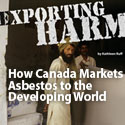May 25, 2007
Dear RightOnCanada Supporter, It’s hard to believe, but the Harper government, dedicated to ever greater integration of Canada into the US, wants to “harmonize” the types and levels of pesticide residue allowed on fruits and vegetables and in dairy products with those of the US and Mexico. It’s part of plans being made behind closed doors to streamline Canadian standards with often lower U.S. standards, instead of improving our standards to those adopted by the European Union. Our government apparently sees regulations to protect public health as a “free trade irritant.” And pesticides are just the beginning. Some 300 regulatory regimes are going through the same race-to-the-bottom process under the auspices of the Security and Prosperity Partnership – so-called “deep integration” – signed by Canada, the U.S. and Mexico. Please take 60 seconds to send a message to Prime Minister Harper right now urging him to put the health of people and the environment first. You can make a difference. Thank you,
Kathleen Ruff
Yummy! More pesticide For a minority government eager to burnish its environmental and centrist credentials, the two Monday announcements were astonishing: Alberta’s oilsands will be exempted from certain emissions requirements placed on other heavy polluters, and pesticide regulations for fruits and vegetables are being relaxed to fit with lower U.S. standards. By exempting oilsands plants from new limits on some of the most worrisome smog-causing pollutants, particularly nitrogen oxide, Stephen Harper’s government gives the impression it was never serious about the clean air agenda it tried to push as an alternative to the Kyoto accord. It would be one thing to grandfather older industries that might have trouble reaching more stringent emissions levels in a short period of time, but the oilsands industry is one in which new, more efficient and cleaner technologies are constantly being developed. Letting it off the hook sends too many bad political signals to the rest of Canada: that Alberta is special; that polluters needn’t strive to be cleaner; that it’s OK to pollute the North; and that good lobbying trumps good environmental policy. And similar signals were sent by a decision to “harmonize” the amounts of pesticide residues allowed on fruits and vegetables in Canada, the U.S. and Mexico. Yes, the move was done under the auspices of the North American Free Trade Agreement. Both the U.S. and Mexico tend to have higher limits because there are more pests to contend with in warmer climes. But the memories of most Canadians are probably not as short as the government apparently believes. When the original Canada-U.S. Free Trade Agreement and the subsequent NAFTA were being negotiated during the Mulroney years, Canadians were assured that when standards were in conflict, the highest would prevail. Remember being repeatedly promised that there would be “no rush to the bottom” for environmental standards? Well, don’t look now, but it appears “down” is the current heading. Health Canada officials downplay the changes, saying the new rules are largely irrelevant since most producers use only a fraction of the amount of pesticides they did when the standards were established. But that only further raises suspicions, for wouldn’t it make more sense to raise standards to reflect current usage in NAFTA countries than to simply drop them to the lowest prevailing among the “three amigos”? As understanding grows of the health risks of persistent organic pollutants — chemical compounds that are found in at least nine common pesticides, and that accumulate on plants, in water, in the soil and, over the years, in humans and other animals — the only reasonable action of the government would be to press for their reduced use. Who benefits if the Canadian Food Inspection Agency relies more on U.S. Food and Drug Administration inspectors to do their work? What legal recourse is there if, down the line, something gets missed and toxins find their way into the Canadian food system? The Harper government needs to step back from fast-tracked talks with the U.S. on a Security and Prosperity Partnership and convey to the other side that, while harmonizing standards is a good idea, dropping them to the lowest common denominator is not.
OTTAWA — Think those grapes look suspiciously dusty? Better break out the veggie-scrubbers: Canada is set to raise its limits on pesticide residues on fruit and vegetables for hundreds of products. The move is part of an effort to harmonize Canadian pesticide rules with those of the United States, which allows higher residue levels for 40 per cent of the pesticides it regulates. Differences in residue limits, which apply both to domestic and imported food, pose a potential “trade irritant,” said Richard Aucoin, chief registrar of the Pest Management Regulatory Agency, which sets Canada’s pesticide rules. However, Canada will only raise its limits “where this poses no risks,” he stressed. U.S. pesticide residue limits are often higher because the country’s warmer climate means it is plagued by more pests, Aucoin said. The agency is reviewing its limits on a case-by-case basis, he said. But Canada should never lower it standards in the name of harmonization, said David Boyd, an environmental lawyer and author of a 2006 study of international pesticide regulations. “We should look to equal or surpass the best in the world, not only measure ourselves against the U.S.,” where regulations are weaker than in jurisdictions such as the European Union, he said. Canadian regulators and their U.S. counterparts have been working to harmonize pesticide regulations since 1996, as part of the North American Free Trade Agreement. Now the effort is being fast-tracked as an initiative under the Security and Prosperity Partnership (SPP), a wide-ranging plan to streamline regulatory and security protocols across North America. The SPP’s 2006 report identified stricter residue limits as “barriers to trade.” Boyd’s report, published by the B.C.-based David Suzuki Foundation, raised concerns about the levels of pesticide residue allowed both in the U.S. and Canada. Comparing 40 U.S. limits with those set by Canada, the European Union, Australia and the World Health Organization, he found the U.S. had the weakest rules for more than half of the pesticide uses studied. In some cases the differences were dramatic: The U.S. allows 50 times more vinclozolin on cherries as the E.U., and 100 times as much lindane on pineapples. Canada fared no better: For permethrin on leaf lettuce and spinach, the Canadian and U.S. limit was 400 times higher than in Europe, and the Canadian cap on methoxychlor was 1,400 times the European limit. Both countries also allow pesticides that have been banned not only in Europe but also in some developing countries, Boyd noted. Methamidophos, for example, is permitted in Canada but banned in Indonesia and other developing nations, he found. The pesticide is now being re-evaluated in Canada. Aucoin said residue limits are set according to exacting standards in Canada, adding differences in ecosystems and patterns of use can account for the variation from country to country. Raising the limits “will not change the amount of pesticides coming into the country,” he said, noting the residue levels on imported produce are usually well below even the Canadian limits. |
| RightOnCanada.ca is a project of the Rideau Institute.For information, please contact: Mohamed Hamdan, Administrative Assistantoperations@rideauinstitute.ca30 Metcalfe Street, Suite 500 Ottawa ON K1P 5L4 CanadaTel. 613 565-4994 Fax 613 237-3359www.rideauinstitute.caIf you received this newsletter through a friend, please consider becoming a subscriber .The Rideau Institute is a public interest research organization federally incorporated as a not-for-profit organization with Industry Canada under the Canada Corporations Act. Unfortunately, donations to the Rideau Institute are not tax deductible. |








Fri, May 25, 2007
RightOnCanada.ca E-Bulletins